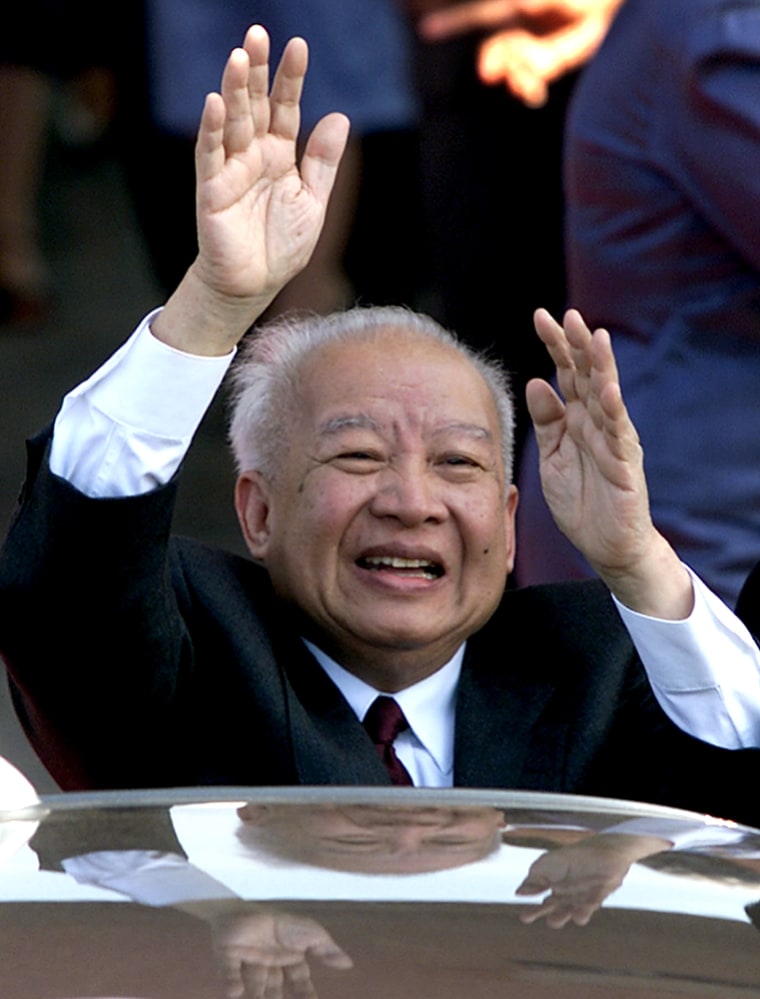King Norodom Sihanouk, known as much for his colorful personality as his controversial statesmanship, has been synonymous with Cambodia’s modern history for six decades. His era drew to an apparent close Thursday, when he stunned the country by announcing his abdication.
In a letter sent from China, where he has often sought medical treatment in recent years, the monarch cited a new and serious stomach ailment and asked “all compatriots to please allow me to retire.”
Sihanouk — who turns 82 this month — has threatened many times to quit the throne, usually if some political deal or conditions weren’t met. The moves were mostly seen as a cross between canny political maneuvering and throwing a temper tantrum.
But this time, no ulterior motive was apparent.
Sihanouk did much to earn the description of “mercurial monarch” through decades of political feints and jabs, shifting alliances and self-dramatizing pronouncements, delivered in his high-pitched voice or, more recently, via his personal Web site.
Not what the French had in mind
Sihanouk entered public life when he was installed as king by the French in 1941, when Cambodia was one of their Indochinese colonies.
However, Sihanouk turned on the French, who had considered him a wastrel prince who would be easy to manipulate, and led a successful crusade for independence, achieved in 1953.
Two years later, Sihanouk stepped down from the throne, organized a political party and steered Cambodia toward uneasy neutrality at the height of the Cold War.
Domestically, Cambodia was a one-man show. Sihanouk’s sharpest critics described him as an ancient Khmer ruler reincarnated in Western dress.
His security forces ruthlessly persecuted dissidents, sending the French-educated leaders of the Communist Party into the jungles, where they would eventually emerge as the Khmer Rouge.
Ouster of a father figure
Cunning and charming by turn, Sihanouk made movies, painted, composed music, fielded a palace soccer team and led his own jazz band. His large appetite extended to fast cars, food and women.
“I am Sihanouk,” he once said, “and all Cambodians are my children.”
As the Vietnam War bumped up against Cambodia’s borders in the 1960s, Sihanouk typically played both sides against the other.
He allowed the communist North Vietnamese to move south though Cambodian territory, while not making much of a fuss when the U.S. military bombed those forces.
The Vietnamese responded by putting more troops into Cambodia and strengthening their Cambodian communist colleagues, polarizing Cambodia’s politics and leading to Sihanouk’s ouster in 1970 by members of the country’s pro-American elite.
In no time at all, Sihanouk, who had been traveling abroad at the time of his ouster, allied himself with the communists his secret police had hunted down less than a decade earlier.
Brush with the Khmer Rouge
Sihanouk’s popularity with most Cambodians, who look upon him as a god-king, was more valuable than a shipload of arms. The Khmer Rouge, who carefully hid their radical agenda, were able to paint their fight as a nationalist struggle, drawing sympathy not only among Cambodians, but also abroad.
The alliance left Sihanouk open to criticism that he opened the way for the Khmer Rouge holocaust. The regime is blamed for the deaths of 1.7 million people during their late 1970s rule.
When Sihanouk returned home after the victory of the Khmer Rouge, they detained him and considered executing him. Only the personal intervention of Chinese leader Chou En-lai saved him.
Sihanouk was freed as Vietnamese forces invaded Cambodia in 1978 and toppled the Khmer Rouge. He went back into exile, mostly in Beijing and North Korea.
From there, he headed an unlikely coalition of communist and anti-communist guerrilla groups fighting the Vietnamese-installed puppet government. The war lasted a decade.
Back in his throne
In a classic mix of politics and theater — bringing his French poodle to negotiations, singing love songs over elaborate dinners — Sihanouk engineered a cease-fire and moves toward national unity and peace.
After U.N.-supported democratic elections in 1993, Sihanouk re-ascended the throne, becoming a constitutional monarch with little real power but a fair amount of influence.
As his health declined and he spent increasing amounts of time abroad — for medical treatment and, he implied, to register his disapproval of the country’s elected leaders — his profile and influence receded.
While old people in the countryside still held him in reverence, the young generation regarded him as a figure of the past and one partly responsible for Cambodia’s tragedy.
